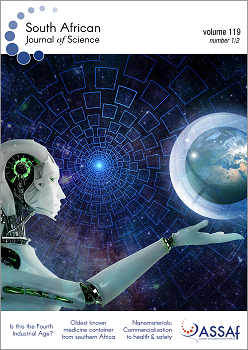Current situation and future prognosis of health, safety and environment risk assessment of nanomaterials in South Africa
DOI:
https://doi.org/10.17159/sajs.2023/11657Keywords:
nanotechnology, responsible development, characterisation, hazard identification, exposure assessment, effects assessmentAbstract
The commercialisation and everyday use of nanomaterials and nanomaterial-enabled products (NEPs) is rising year-on-year. Responsible development of nanotechnology includes understanding their potential implications on health, safety, and the environment (HSE). The health risk assessment of nanomaterials has therefore become one of the major activities of international agencies including the Organisation for Economic Co-operation and Development and the Environmental Protection Agency for protection of human health and the environment. Nationally, with the foresight and the leadership of the Department of Science and Innovation, a HSE programme was initiated to establish the necessary infrastructure to conduct the tests in the hazard identification and exposure assessment that are needed in the risk assessment of nanomaterials synthesised as well as NEPs available in South Africa. Here we present the advances that have been made in elucidating the different facets that are required when undertaking risk assessments of nanomaterials, i.e. physicochemical characterisation, hazard identification, exposure assessment and effects assessment. These facets are increasingly being considered throughout the nanomaterials present in the life cycles of NEPs. South Africa's research contribution to an international understanding of HSE risks of nanomaterials is highlighted and the future direction to generate the necessary information for effective risk communication and management is provided. This will assist in ensuring safer innovation of nanotechnology in South Africa and support the export of locally manufactured nanomaterials as per international requirements.
Significance:
- Significant contributions of South Africa to the nanomaterial HSE knowledge base are highlighted.
- Development of standardised testing methodologies in nanomaterial HSE and protection of human and ecological health through risk assessment of nanomaterials are discussed.
- This paper contributes to ensuring safer innovation of nanotechnology in South Africa.
Published
Issue
Section
License

All articles are published under a Creative Commons Attribution 4.0 International Licence
Copyright is retained by the authors. Readers are welcome to reproduce, share and adapt the content without permission provided the source is attributed.
Disclaimer: The publisher and editors accept no responsibility for statements made by the authors
How to Cite
- Abstract 489
- PDF 808
- EPUB 383
- XML 435













.png)